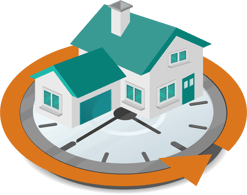
BASICS
OVERVIEW


Overview of a Reverse Mortgage:
A reverse mortgage is a unique loan option available to homeowners aged 62 and older that allows them to draw on the value of their home through a variety of monthly payout selections, a line of credit, a lump sum, or a combination of these options all without making monthly principal and interest payments.
The beautiful thing about this loan and why it is so useful to many Americans, is that repayment is not required until the homeowner(s) no longer reside in the residence, the last surviving borrower passes away, or does not comply with the loan obligations. This allows an individual to utilize these potential payment and the equity that can be accessed to improve their way of life.
Eligibility Requirements:
The HECM loan is an easy loan to qualify for since it is not entirely based on credit, income, and assets like it’s forward counterpart. In fact, we have closed a number of deals that had started with another lender who tried to do a regular mortgage and the client couldn’t qualify. However, with the reverse mortgage we accomplished a successful close and the clients often said that it was a better solution than the forward. They simply didn’t understand the product, nor did the loan officer whom they were dealing with. With that said, here are the basic requirements of a HECM loan:
Have at least one borrower on title who is 62 years or older
Property must be the primary residence of the borrower
HECM Counseling
A financial assessment is required for a HECM loan to determine the borrower’s ability to pay taxes and insurance.
There must also be enough equity in the home. Although the amount required varies depending on factors such as home value, interest rates, and age, the general rule is to guess around 50-60%. We will determine this in the proposal. You can also use the calculator [Insert Link] to get a rough estimate (* please know that this calculator is a worse case scenario, in order to get accurate figures, I’ll need to send you a proposal).
It is important to know there is no need to pay off the home to qualify for a reverse mortgage, and the amount of cash received depends on the borrower’s age, home’s appraised value, expected interest rate, and mortgage option chosen.
Types of Reverse Mortgages:
There are different types of reverse mortgages, the most popular being the Home Equity Conversion Mortgage (also known as the HECM), which is insured by the FHA. There are some proprietary choices for high-value homes as well as borrowers with ages down to 55 years old. You can read more about these in the Jumbo section here. As a Certified Reverse Mortgage Professional, it is my goal to make sure that borrower’s are fully informed in order to make the best decision for their specific and customized needs. Schedule a call to discuss.
Counseling:
One of the key components at the start of the process is to obtain a loan proposal in which you will receive the necessary list of counseling providers required by HUD. In the proposal package, there will be a link and code that you will provide the counselor in order for them to view the same numbers that are contained within the proposal. They will give you an unbiased overview to ensure that you are understanding the reverse mortgage, what it can do, as well as what it can’t do. This safe guard was implemented by HUD in order to protect seniors from any sort of predatory lending.
This counseling is required before any advancement can proceed on your loan. It is also necessary before any money can be received by the broker in order to start your file (ie. appraisals, credit reports, etc.). Most of these agencies do charge a fee for the counseling service, and once obtained, the counselor will email you as well as your loan officer, a copy of the certificate.
Who do I use to find a Reverse Mortgage?:
There are estate planning services that help with obtaining a reverse mortgage, however, this raises the question of cost. According to HUD, it is advisable to avoid services that charge fees (other than the mandatory HECM counseling fee as previously stated) or those that request a lender referral fee. Instead, HUD offers free information and can direct you to HUD-approved housing agencies that provide free or low-cost reverse mortgage counseling and other services. The HECM counseling fee typically costs between $125 and $150, but some agencies may waive it for eligible applicants. To find a HUD-approved housing counseling agency near you, you can call 1-800-569-4287 toll-free.
Unique Features of a Reverse Mortgage:
Evaluating whether a reverse mortgage is a suitable choice can seem overwhelming, but we’re here to simplify things and equip you with the knowledge necessary to make the best decision for both you and your family.
Here are some key features to help you understand this incredible loan:
No monthly mortgage payment. You simply need to make the tax, insurance, and HOA (if applicable) payments as well as maintain the home
Option to convert home equity into cash via lump sum, monthly payments, line of credit, or a combination of options to reach your goals
Not only are proceeds are generally tax-free, they could be used to offset taxable events (we would want to consult your CPA, as they are the professional on that)
Line of credit grows at a the same rate that is being charged on the loan and cannot be closed by the lender, which is awesome for future retirement use
Protection for a non-borrowing spouse so they can remain in the home
Interest only accrues on used funds, NOT the line of credit
The HECM Loan is a non-recourse loan, protecting your heirs and estate from debt if the home sells for less than the loan balance
Options for receiving loan proceeds:
There are five different ways to receive payments from an adjustable interest rate reverse mortgage, I’ve also included an example on where/why someone would choose this option to meet their specific goals. Of course, the options are not limited to these examples. So let’s take a look:
Tenure: Monthly payments of equal amounts [subsidize your monthly income where social security and/or pension is not enough]
Term: Monthly payments of equal amounts for a predetermined time period chosen by the borrower [to delay the receipt of social security in order to max out the payments]
Line of Credit: Payments made at different times and in varying amounts as determined by the borrower(s) [to be used for emergencies or to implement a coordinated withdrawal strategy in conjunction with your financial professional]
Modified Tenure: Monthly payments combined with a line of credit [as it says, a combination of these benefits]
Modified Term: Monthly payments for a set number of months combined with a line of credit


HELOC vs. HECM
The difference & why to choose one over the other:
Reverse mortgages have gained popularity as they provide loan proceeds that don’t require immediate repayment, as long as certain requirements are met. The HECM closely resembles a HELOC (Home Equity Line of Credit) as they both offer access to the homeowners equity they've accrued on their primary residence. However, when taking a closer look, they have very different qualifications with many different features as well as protections for the consumer.
Home Equity Loan or Line of Credit:
[-] You must have enough income to cover the debt as well as your other obligations
[-] Your credit needs to be pretty good to qualify
[-] You need to continue making monthly mortgage payments, covering interest and possibly principal
[+] Low closing costs
[-] Can be closed at any time at the banks discretion
Home Equity Conversion Mortgage:
[+] You must meet basic income to cover your living expenses and maintenance on your home
[+] Basic credit overview to insure you have the willingness & capacity to pay your bills as you will be making your tax and insurance payments (Note: if this is an issue, a LESA may be set up to insure these payments can be made)
[+] No monthly principal and interest payments
[+] Line of Credit (if established) cannot be closed unless the qualified borrower ceases to use the property as their primary residence and the non-borrowing spouse remains in the home or the loan is called due because terms are not being met
***Remember, you must continue paying property-related fees, taxes, homeowner’s insurance, and maintain the property in good condition while having a reverse mortgage.
HISTORY OF REVERSE MORTGAGES


Introduction of the Reverse Mortgage (1961-1980):
1961: The concept of reverse mortgages was introduced by Nelson Haynes of Deering Savings & Loan in Portland, Maine. This initial form of reverse mortgage was a fixed monthly payment to seniors against their home equity.
1983: The Reagan administration endorsed the idea of the reverse mortgage as a way to help senior's supplement their retirement income.
In order to satisfy any of curiosity you may have regarding the history of Reverse Mortgages, here is a condensed timeline...
FHA's Home Equity Conversion Mortgage (1987-1990):
1987: The Federal Housing Administration implemented the Home Equity Conversion Mortgage (HECM) program. With this move, a government-insured option for the reverse mortgage was provided.
1989: The HECM program gained popularity, and Congress passed the Home Equity Conversion Mortgage Insurance Demonstration to test and evaluate the viability of the program.
Private Sector Involvement & Growth (1990-2000):
1990s: Private lenders started offering reverse mortgages, expanding the market beyond government-backed programs.
1997: The FHA eliminated the use of public funds to subsidize HECM loans, making the program financially self-sufficient.
Early 2000s: The reverse mortgage market continued to grow, and financial institutions developed various types of products to meet the diverse needs of seniors.
Legislation & Market Challenges (2001-2008):
2001: Congress passed the Financial Freedom Act, aiming to improve consumer protections for the reverse mortgage borrower.
2008: The housing market crisis had a significant impact on the reverse mortgage industry. Falling home values and economic uncertainty raised concerns about the long-term viability of reverse mortgages.
Recovery & Regulatory Changes (2009-2010):
2009: The Housing and Economic Recovery Act (HERA) introduced reforms to the reverse mortgage program, including higher loan limits and increased consumer protections.
2010: The industry experienced increased scrutiny and regulatory changes to address issues of transparency, borrower education, and financial assessment.
This overview provides a broad perspective on the history of reverse mortgages up until 2010. Keep in mind that specific details and events may vary, and for the most accurate and detailed information, referring to NRMLA publications and official documents would be advisable.


